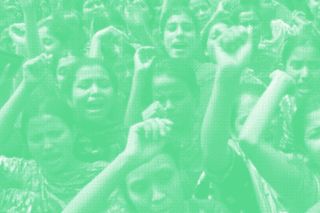
Why Bangladesh’s Ongoing Garment Workers’ Strike Is a Feminist Issue
The link between the ongoing strike and the sweatshop industry is crucial to understanding the systemic issues at play.

Last week in the Gazipur industrial district, just outside Dhaka, thousands of garment workers in Bangladesh walked off their jobs to protest against low wages. The workers along with several others gathered to voice their frustration over higher commodity prices, rent and other bills, which resulted in clashes with security forces and damaging multiple factories, The Hindu reported. This ongoing struggle is over the marginal wage increase by the Bangladesh government in September 2018, which failed to address the workers' concerns, sparking fervent calls for a more substantial raise. The discontent intensified in January 2019, resulting in clashes, and mass dismissals of approximately 12,000 workers. The protests in 2019 pivoted around a demand for a monthly minimum wage increase from Tk 23,000 to Tk 25,000, accompanied by broader labor rights and workplace improvement aspirations.
However, the garment workers' ongoing strike transcends a mere labor dispute, emerging as a profound feminist issue laying bare the complex interplay of gender, poverty, and exploitation in the industry. France24 reports, “Bangladesh's 3,500 garment factories account for around 80% of the South Asian country's $55 billion annual exports, supplying many of the world's top names in fashion. But conditions are dire for many of the sector's four million workers, the 85% of whom are women whose monthly wages start at 8,300 taka ($75)." Predominantly women, these protesting workers are not solely advocating for a substantial increase in their monthly minimum wage but are also demanding comprehensive improvements in working conditions. The scale of participation is significant, with thousands engaged in protests leading to the closure of numerous factories, including international brands such as Levi’s, H&M, reports NDTV.
Sweatshops in Bangladesh, synonymous with the garment industry, have long been scrutinized by critics of the fast-fashion excesses of capitalism, for subjecting women to low wages, poor working conditions, and occupational hazards. The history of this industry highlights how it was built riding the wave of ‘feminization of poverty’ – a rising global trend of gender-related financial vulnerability for women. The UN reports that the majority of the 1.5 billion people living on 1 dollar a day or less are women, implying that the majority of the world's poor – are female.
Economist Janice Peterson argues, “When the word "feminized" is attached to a term, it has generally denoted diminished value, as in feminized occupational groups whose comparable wage value is less than would be expected.” Coined two decades ago, the phrase "the feminization of poverty" is not just a phrase; it encapsulates the harsh reality faced by a significant portion of Bangladesh's female workforce. Conceptualized to describe the disproportionate poverty experienced by women, this phenomenon is starkly evident in the garment industry. Since a majority of garment workers in Bangladesh are women, toiling for long hours under challenging conditions, yet their wages remain significantly lower than their male counterparts – the protests have not only revealed the stark divide between workers and factory owners but also underscore the historical role of women in such occupations.
From the textile mills of the Industrial Revolution to the modern-day sweatshops in developing countries, women have been at the forefront of the struggle for fair labor practices. Yet their struggles have been overshadowed by the prevailing narrative that these jobs are opportunities for women in impoverished regions, ignoring the exploitative nature of the conditions they endure.
The historical continuum of sexual division of labor relies on relegating women’s labor to the domestic sphere, which is subjected to devaluation as it lies outside the economic production of profits. “Sewing was a social expectation for women” according to Emma Thompson, a Women’s Studies scholar. "Not only was sewing seen as a domestic duty, but it was also a key act in creating feminine virtues such as 'thrift, practical creativity, and attention to appearance.' Sewing for children also signified that a woman was a nurturing mother," she writes. However, the transference of gendered labor dynamics from the days of domestic production to the modern factory’s assembly line has not seen much interruption. Women and children, integral to the pre-industrial domestic clothing production system, found themselves working in overcrowded and unsanitary cottages and workrooms alongside the emerging industrialization, notes HistoryToday.
Capitalism relies on the exploitation of certain labor, and women have historically been assigned roles that are both necessary for the functioning of society and economically undervalued. The gendered nature of this economic logic is unmistakable – the very nimbleness and agility that make women preferred in this industry allows the owners to extract more labor for fewer wages. The belief that women ‘have always sewed’ and thus, are more dexterous and adaptable to repetitive tasks perpetuates discriminatory practices, reinforcing the cycle of economic inequality. This preference confines women to low-wage occupations and perpetuates systemic exploitation. In turn, these low wages exacerbate the struggles faced by female workers, trapping them in a vicious cycle of poverty. In other words, the industry's reliance on cheap labor from women further perpetuates a system thriving on the exploitation of the most marginalized.
According to scholars two phenomena have contributed to this trend: first, the overrepresentation of women among minimum-wages and unpaid workers; second, the rising percentage of women who head households with dependent children. Sociologist Fauzia Erfan Ahmed, explaining the indispensable nature of women's employment in the garment industry, highlights, “these jobs are crucial for household welfare” and that is what makes them [women] “compliant workers” – lucrative to the exploitative demands of the factory set-up. Despite the occupational hazards and taxing conditions “some single women find empowerment in their earnings, although married women often struggle to leverage income for greater decision-making power” she adds.
The sweatshops, which over the time became the building block for the third-world's developing economy, originated in the neo-colonial desires of the West to enjoy cheaply manufactured goods, by devaluing the provincial worker’s labor in the supply chain of production. But the double incidence of this capitalist-patriarchal network falls upon marginalized women, who are compelled to earn their sustenance in a system which is rigged against them.
War on Want reports, “Since 1990, more than 400 workers have died and several thousand more have been wounded in 50 major factory fires. Sexual harassment and discrimination is widespread and many women workers have reported that the right to maternity leave is not upheld by employers. Factory management also took steps to prevent the formation of trade unions, a right protected under the Freedom of Association and Collective Bargaining ILO Conventions, which Bangladesh ratified in 1972”. The UN Special Rapporteur on extreme poverty and human rights, Olivier de Schutter, said, “The minimum wage in the readymade garment sector is Taka 8,000 per month, which is probably one-third of what would allow a worker in this industry to make a decent living and to support his or her family. Unfortunately, when the unions demand higher wages, the response given to them is that if the wages are not kept low, the big buyers will move to other countries, will cancel their orders, and the competitiveness of Bangladesh in global markets will be threatened. I do not think that the development of a country can be premised on keeping workers in poverty.” A Bangladeshi reporter providing a ground report of the situation writes, "The debts are piling up in the neighborhood grocery shops, and much-needed treatment has been put on hold till ‘better times’ arrive. Women's health, as always, has been the worst-affected, as the opportunity cost of an ultrasound is two weeks' worth of food on the table for their kids. Most are surviving by working an insane amount of hours day in and day out – it is now legal to work up to 12 hours a day, thanks to a circular by the labor ministry – at a great cost to their mental and physical health, on top of taking on additional manual work on their so-called weekend to earn some extra bucks.”
A narrative study of such women worker sweatshops, reported, “their work has led to back and joint pain, continuous headache, eye pain and difficulty in breathing associated with inhaling fabric dust. Inadequate lighting, constantly sitting in one position without backrest and continuous noise from hundreds of machines makes them feel permanently tired. Further, the female workers reported that working in the factory and meeting the expectations of the families at home has doubled their workload.” Occupational health hazards intensify the plight of female garment workers, reflecting a blatant disregard for human rights. The predominantly female workforce faces risks often overlooked in pursuit of profit, jeopardizing not only economic stability but also health and well-being. This discriminatory practice exacerbates the feminization of poverty, as women are confined to low-wage occupations, perpetuating a cycle of economic inequality.
Furthermore, the assumption that women's participation in the labor force is limited due to family constraints has been a prevailing mindset. The burden of caregiving and household responsibilities often falls disproportionately on women, limiting their ability to advocate for fair wages and improved working conditions. This gendered division of labor not only reinforces harmful societal norms but also perpetuates the cycle of exploitation over women.
“The urgency is clearly lost on the wage board members, who could only manage to meet three times over the past six months, and, by their own admission, are yet to even visit factories and meet with the workers,” notes DailyStar, a Bangladeshi news outlet. “We, as a nation, have had no problems standing on the back of our workers – and breaking them if need be. We have taken their so-called resilience for granted, assuming that no matter the injustice, they can somehow sustain on poverty wages, with nothing but cheap vegetables and rice to eat, and work non-stop till their youth give out prematurely. The wage board must do the humane thing – declare Tk 25,000 as the minimum wage – instead of proposing a hike that reflects the desires of the owning class and falls frustratingly short of the workers' demands," the article concludes.
The link between the ongoing strike and the sweatshop industry is crucial to understanding the systemic issues at play. To address these issues, a comprehensive approach is required – one that recognizes the inherent dignity and rights of female workers. It is imperative to challenge gender stereotypes, dismantle discriminatory practices, and advocate for fair wages and safe working conditions. Only by dismantling the structures that perpetuate the feminization of poverty can we hope to create a more just and equitable future for the women who form the backbone of the garment industry in Bangladesh.
Naina is a sociology graduate of the Delhi School of Economics. She presently works as a writer focusing on queer theory, culture, media semantics, and women's health.
Related


We Have to Retire the Phrase ‘Women and Children’ in Conflicts
.jpg?rect=0,80,1280,1280&w=320&h=320&fit=min&auto=format)